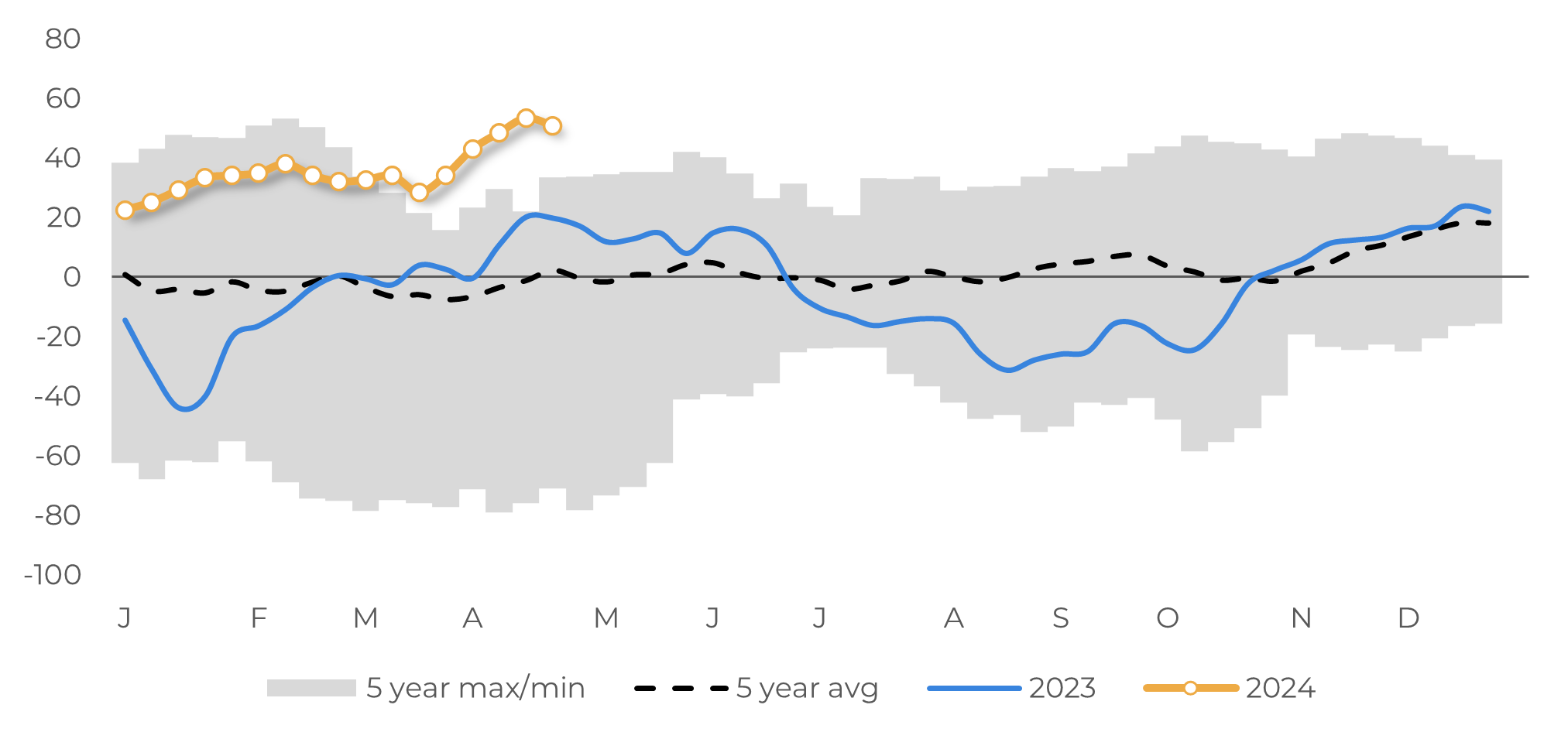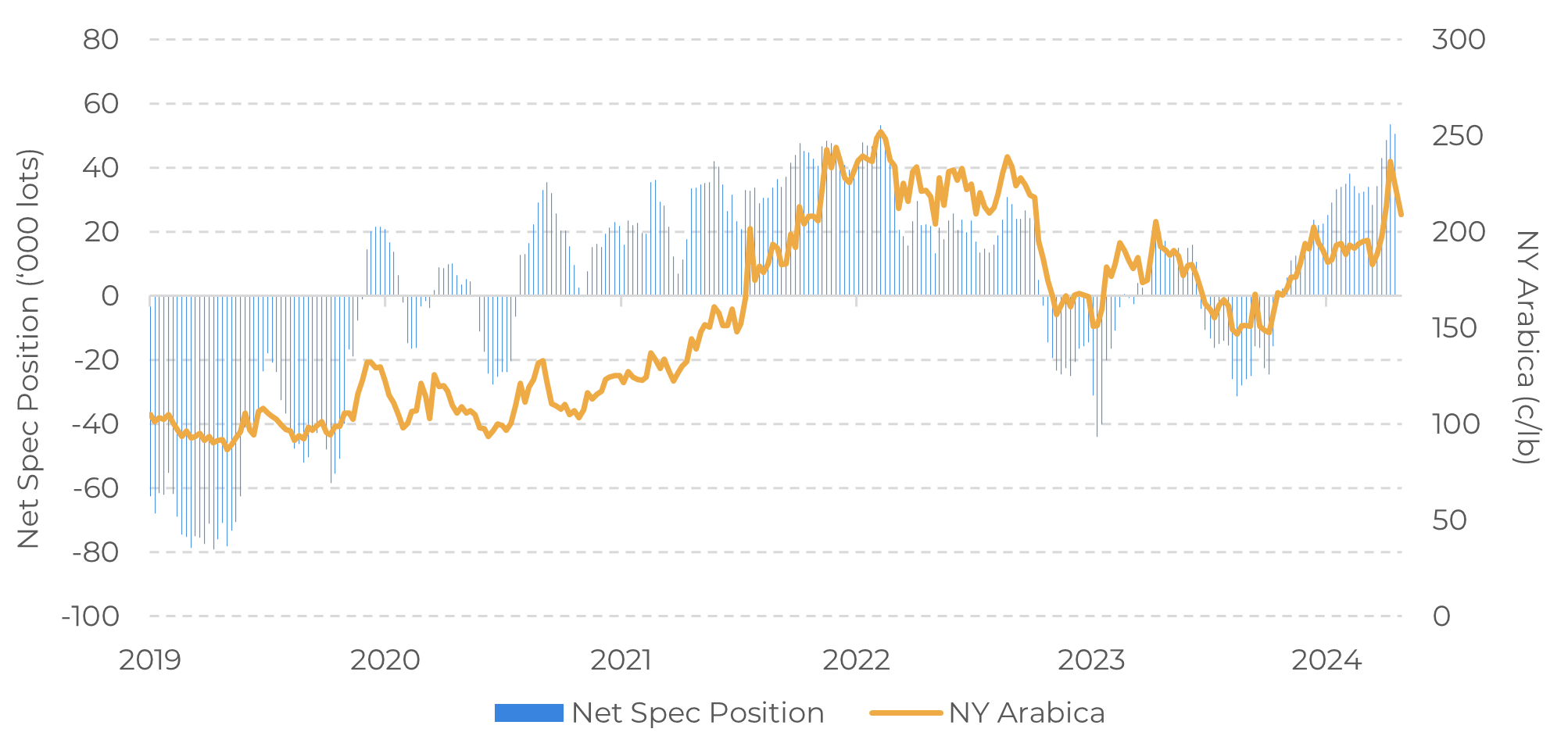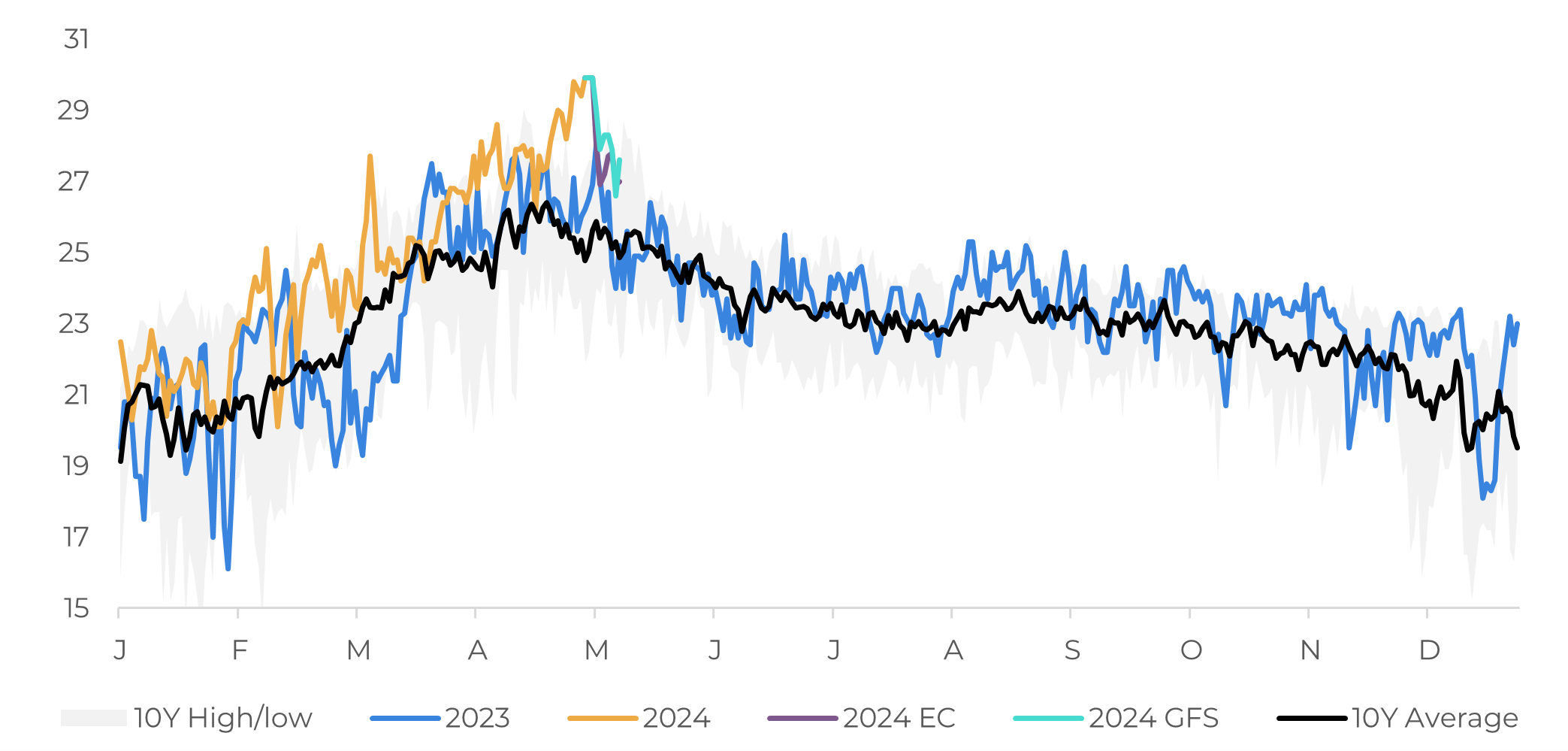
May 3
/
Natália Gandolphi
Coffee Weekly Report - 2024 05 03
Back to main blog page
- Coffee prices continued their decline this week, mirroring trends in other soft commodities like sugar and cocoa. Prices have been more driven by speculative moves rather than changes in market fundamentals, with coffee prices down around 15% from previous highs, positioning them between the decreases seen in sugar and cocoa. Linear regression analysis suggests prices could settle around the 202-209 c/lb mark, all else equal.
- The market continues to monitor developments in Vietnam, where forecasts for increased rainfall have not yet translated into recovery. Current weather concerns include lower-than-expected rainfall and higher-than-normal temperatures, which may affect the development of the 2024/25 crop.
- Meanwhile, coffee roasters have experienced a slight slowdown in the first quarter, particularly for in-home consumption. For example, KDP reported a 0.3% decrease in U.S. coffee volume sales in Q1 2024, with a 1% drop from last year, suggesting slight shifts in demand patterns.
Coffee prices align with softs’ trend
This week, coffee prices remained on the downtrend, alongside other softs commodities. Prices have also mirrored other benchmarks, such as oil: front-month WTI prices fell by roughly 8% since mid-April, and while coffee responded more aggressively (about -15%), it stayed in the middle of the road between sugar and cocoa (roughly -10%, and -30%, respectively, considering the previous highs).
So far, price decreases have been more correlated to spec moves than fundamentals themselves. For instance, in our monthly analysis, we’ve been observing the vulnerability implicit to record-high spec positions (Figure 1). It is important to note, however, that going by the correlation between prices and spec position, there was more room for correction, towards 202-209 c/lb, considering a linear regression for the past 70 periods, since January 2023 and the 5-year series – the level that the first contract is currently testing (Figure 2).
Other points have also been watched by the market, despite not currently altering the global Supply & Demand balance: results from coffee roasters showed a slowdown in the first quarter, especially for results that reflect more in-home consumption. KDP, for instance, posted a -0.3% variation in U.S. coffee volume sales in 1Q/24, and a 1% drop compared to the same period last year.
Figure 1: Arabica Net Spec Position (‘000 lots)

Source: CFTC
Figure 2: Arabica Net Spec Position and NY Arabica Prices

Source: CFTC, Refinitiv, ICE
Nonetheless, as previously mentioned, the correction does not reflect the fundamentals that were being watched more closely by the market and providing support – especially to LN robusta prices. Namely, concerns regarding the early stages of development in Vietnam.
Even though forecasts continue to suggest an increase in rainfall levels over the next weeks – with 2-week forecasts suggesting from 90% to 150% of normal volumes, compared to the current 0% to 20% - these forecasts are yet to effectively translate into a recovery. Figure 4 shows the cumulative rainfall levels for 2024 in the Central Highlands region, accompanied by the EC and GFS forecasts.
In tandem, temperatures are yet to come back down from historical highs: according to Refinitiv data, the region reported temperatures at 29.9°C in the past few days, while the average expected for the period would be around 25°C. In this sense, it’s not just irregular rainfall patterns that threaten soil moisture at this point, and consequently, the development of the 24/25 crop.
Figure 3: Average Temperature – Central Highlands (°C)

Source: Refinitiv
Figure 4: Cumulative Precipitation – Central Highlands (mm)

Source: Refinitiv
In Summary
Coffee prices continued to decline this week, in line with other soft commodities like sugar and cocoa. The drop in coffee prices seems more related to speculative moves rather than fundamental market factors. There was potential for further price correction based on a linear regression analysis, aiming for around 202-209 c/lb, but now, it is the level being currently tested. Despite some positive outlooks for increased rainfall in Vietnam, forecasts haven’t yet led to a clear recovery, as the region experiences higher-than-average temperatures. Additionally, coffee roasters showed a slight slowdown in the first quarter, with a focus for in-home consumption patterns – although results aren’t resonating throughout all categories, which limits the bearish pressure.
Weekly Report — Coffee
Written by Natália Gandolphi
natalia.gandolphi@hedgepointglobal.com
natalia.gandolphi@hedgepointglobal.com
Reviewed by Laleska Moda
laleska.moda@hedgepointglobal.com
www.hedgepointglobal.com
Disclaimer
This document has been prepared by hEDGEpoint Global Markets LLC and its affiliates ("HPGM") exclusively for informational and instructional purposes, without the purpose of creating obligations or commitments with third parties, and is not intended to promote an offer, or solicitation of an offer, to sell or buy any securities or investment products. HPGM and its associates expressly disclaim any use of the information contained herein that may result in direct or indirect damage of any kind. If you have any questions that are not resolved in the first instance of contact with the client (client.services@hedgepointglobal.com), please contact our internal ombudsman channel (ouvidoria@hedgepointglobal.com) or 0800-878-8408 (for clients in Brazil only).
Contact us
hedgepointhub.support@hedgepointglobal.com
ouvidoria@hedgepointglobal.com
Funchal Street, 418, 18º floor - Vila Olímpia São Paulo, SP, Brasil
Check our general terms and important notices.
This page has been prepared by Hedgepoint Schweiz AG and its affiliates (“Hedgepoint”) solely for informational and instructional purposes, without the purpose of instituting obligations or commitments to third parties, nor is it intended to promote an offer, or solicitation of an offer of sale or purchase relating to any securities, commodities interests or investment products. Hedgepoint and its associates expressly disclaim any use of the information contained herein that directly or indirectly result in damages or damages of any kind. Information is obtained from sources which we believe to be reliable, but we do not warrant or guarantee the timeliness or accuracy of this information. The trading of commodities interests such as futures, options, and swaps involves substantial risk of loss and may not be suitable for all investors. You should carefully consider wither such trading is suitable for you in light of your financial condition. Past performance is not necessarily indicative of future results. Customers should rely on their own independent judgement and/or advisors before entering in any transaction.Hedgepoint does not provide legal, tax or accounting advice and you are responsible for seeking any such advice separately.Hedgepoint Schweiz AG is organized, incorporated, and existing under the laws of Switzerland, is filiated to ARIF, the Association Romande des Intermédiaires Financiers, which is a FINMA-authorized Self-Regulatory Organization. Hedgepoint Commodities LLC is organized, incorporated, and existing under the laws of the USA, and is authorized and regulated by the Commodity Futures Trading Commission (CFTC) and a member of the National Futures Association (NFA) to act as an Introducing Broker and Commodity Trading Advisor. HedgePoint Global Markets Limited is Regulated by the Dubai Financial Services Authority. The content is directed at Professional Clients and not Retail Clients. Hedgepoint Global Markets PTE. Ltd is organized, incorporated, and existing under the laws of Singapore, exempted from obtaining a financial services license as per the Second Schedule of the Securities and Futures (Licensing and Conduct of Business) Act, by the Monetary Authority of Singapore (MAS). Hedgepoint Global Markets DTVM Ltda. is authorized and regulated in Brazil by the Central Bank of Brazil (BCB) and the Brazilian Securities Commission (CVM). Hedgepoint Serviços Ltda. is organized, incorporated, and existing under the laws of Brazil. Hedgepoint Global Markets S.A. is organized, incorporated, and existing under the laws of Uruguay. In case of questions not resolved by the first instance of customer contact (client.services@Hedgepointglobal.com), please contact internal ombudsman channel (ombudsman@hedgepointglobal.com – global or ouvidoria@hedgepointglobal.com – Brazil only) or call 0800-8788408 (Brazil only).Integrity, ethics, and transparency are values that guide our culture. To further strengthen our practices, Hedgepoint has a whistleblower channel for employees and third-parties by e-mail ethicline@hedgepointglobal.com or forms Ethic Line – Hedgepoint Global Markets.Security note: All contacts with customers and partners are conducted exclusively through our domain @hedgepointglobal.com. Do not accept any information, bills, statements or requests from different domains and pay special attention to any variations in letters or spelling, as they may indicate a fraudulent situation.“HedgePoint” and the “HedgePoint” logo are marks for the exclusive use of HedgePoint and/or its affiliates. Use or reproduction is prohibited, unless expressly authorized by HedgePoint. Furthermore, the use of any other marks in this document has been authorized for identification purposes only. It does not, therefore, imply any rights of HedgePoint in these marks or imply endorsement, association or seal by the owners of these marks with HedgePoint or its affiliates.
We have updated our Terms & Conditions to reflect improvements to our platform, data handling practices, and the overall experience we provide to our clients.
To continue using the Hedgepoint HUB, please review and accept the updated terms.

